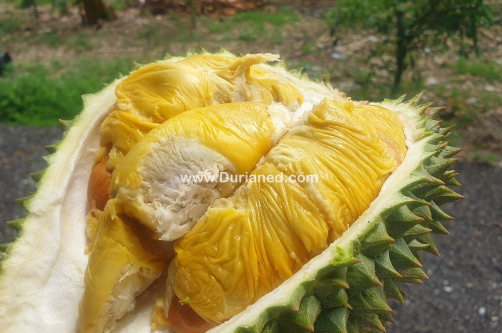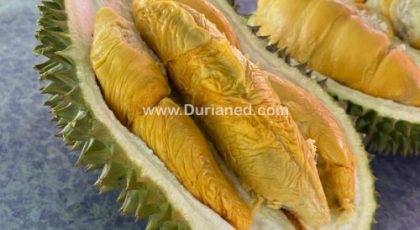Kunyit Balik Pulau Durian
There are a few words or phrases are synonymous with the naming of durians in Malaysia.
Some of the ones that you can find in the names of various different durians include “merah”, “batu”, “hijau”, etc. Another word that has made it’s way into many durian names is “kunyit”.
Just the mere mention of this word and durians like nasi kunyit, the original raja kunyit, and even jawi kunyit comes to mind. They incorporate the word kunyit into the name because it is a Malay word that translates to tumeric. And the durian aril usually spots golden yellow that reminds one of the colour of tumeric.
Many of these kunyit-related durians can be found in Penang. And the owner of one from Pulau Betong found it so special that he decided to register it with MARDI.
In 2022, Kunyit Balik Pulau was successfully registered with the official registration number D218.
D218 Kunyit features
This durian is average sized. Not too big and not too small.
You should be able to find it mostly weighing between the 1.5kg-2.5kg range.
I hate to say this. But I’ve seen musang kings with thorns that look like this durian. It’s not that the thorns of kuynit D218 resembles that of standard musang king. But because there are so many musang kings that many have thorns that don’t resemble that of “standard” thorns. They have mutated. And I’ve seen many such musang kings with thorn arrangements and features that look very similar to D218.
This can make it harder for general consumers to differentiate between them.
The overall shape is usually not fully shaped. There will be compressed areas or lopsided unlike fully shaped A fruits like a round black thorn or fully oval musang king. And it spots a pointed bottom.

This implies that you will find a lot of empty spaces within a “room” and even many empty “rooms”. In fact once it’s opened, don’t be surprised to see more white inner husk than yellow magic.
I would say that the appearance of it’s fruitlets to husk ratio reminds me of tupai king. The difference is that you can observe a very thick inner husk on tupai. Noticeably thicker than kunyit balik pulau.
But this is one of those durians where the sages would bless us with their wisdom of “It’s about the quality, not quantity”.
When opened, the aril can often spot majestic gold like musang king. Which is why unscrupulous durian sellers often like to label this durian as Penang kunyit MSW to price it higher.

This durian is certainly no slouch in terms of visual appeal and connoisseur taste.
It’s as creamy as the king. Thick in consistency, sticky in texture and dense in flavour.
Unlike standard musang king, this kunyit balik pulau almost always carries with it a strong fermented taste. This is almost like a trademark that a lot of famous durians from Penang embodies.
And when you are lucky, you will find that there is gas trapped in the air pockets of the aril that attempts to carry that fermented finesse up your nostrils like an express elevator.
Penang kunyit, this one in particular which proudly identifies itself as originating from Balik Pulau, is one of those durians that wise-guys you run into at the durian stores constantly brag about.
“You like musang king? But you’ve never tried kunyit which is even better!” This is the type of kunyit they are referring to. Conspiracy theorists might even insist that these are the ancestors of musang king.
Like musang king, the seeds of balik pulau kunyit can be flat. But do not mistake this as the kunyit from Kelantan which is the real ancestor of musang king. Those kunyit tend to have a heavier bitterness taste profile and a denser durian flavour.
Kunyit harvest season
The rate of harvesting Kunyit starts to accelerate during the main season. But this is surprisingly not an easy durian to find.
And when you do find one. It seldom disappoints.
There will be some pieces here or there in the stalls in the city. But you will almost never see a whole basket of it or a huge number piled up on display.
This is because the trees don’t harvest bountifully.
Another reason is that it is too similar to musang king. Which has an attractive market price. So it is understandable for a farmer to go for a less risky investment which also provides a better return.
For this similar reason, because of how similar it is to musang king, you would often find kunyit posing as musang king. Because to be honest, most people will not be able to tell them apart when they are extracted out of the husk and put into a box.
They look the same, taste magnificent, as sticky as many elite durians, and even have flat seeds to boot. So take this as a doppelganger alert.
Some of the other names used to market this durian are Penang MSW, old ginger, kunyit MSW.





